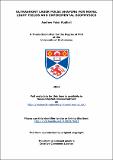Files in this item
Ultrashort laser pulse shaping for novel light fields and experimental biophysics
Item metadata
| dc.contributor.advisor | Dholakia, Kishan | |
| dc.contributor.author | Rudhall, Andrew Peter | |
| dc.coverage.spatial | 166 | en_US |
| dc.date.accessioned | 2013-06-13T09:21:53Z | |
| dc.date.available | 2013-06-13T09:21:53Z | |
| dc.date.issued | 2013-06-26 | |
| dc.identifier.uri | https://hdl.handle.net/10023/3682 | |
| dc.description.abstract | Broadband spectral content is required to support ultrashort pulses. However this broadband content is subject to dispersion and hence the pulse duration of corresponding ultrashort pulses may be stretched accordingly. I used a commercially-available adaptive ultrashort pulse shaper featuring multiphoton intrapulse interference phase scan technology to characterise and compensate for the dispersion of the optical system in situ and conducted experimental and theoretical studies in various inter-linked topics relating to the light-matter interaction. Firstly, I examined the role of broadband ultrashort pulses in novel light-matter interacting systems involving optically co-trapped particle systems in which inter-particle light scattering occurs between optically-bound particles. Secondly, I delivered dispersion-compensated broadband ultrashort pulses in a dispersive microscope system to investigate the role of pulse duration in a biological light-matter interaction involving laser-induced cell membrane permeabilisation through linear and nonlinear optical absorption. Finally, I examined some of the propagation characteristics of broadband ultrashort pulse propagation using a computer-controlled spatial light modulator. The propagation characteristics of ultrashort pulses is of paramount importance for defining the light-matter interaction in systems. The ability to control ultrashort pulse propagation by using adaptive dispersion compensation enables chirp-free ultrashort pulses to be used in experiments requiring the shortest possible pulses for a specified spectral bandwidth. Ultrashort pulsed beams may be configured to provide high peak intensities over long propagation lengths, for example, using novel beam shapes such as Bessel-type beams, which has applications in biological light-matter interactions including phototransfection based on laser-induced cell membrane permeabilisation. The need for precise positioning of the beam focus on the cell membrane becomes less strenuous by virtue of the spatial properties of the Bessel beam. Dispersion compensation can be used to control the temporal properties of ultrashort pulses thus permitting, for example, a high peak intensity to be maintained along the length of a Bessel beam, thereby reducing the pulse energy required to permeabilise the cell membrane and potentially reduce damage therein. | en_US |
| dc.language.iso | en | en_US |
| dc.publisher | University of St Andrews | |
| dc.rights | Creative Commons Attribution-NonCommercial-NoDerivs 3.0 Unported | |
| dc.rights.uri | http://creativecommons.org/licenses/by-nc-nd/3.0/ | |
| dc.subject | Pulse shaping | en_US |
| dc.subject | Multiphoton | en_US |
| dc.subject | Nonlinear optics | en_US |
| dc.subject | Second harmonic generation | en_US |
| dc.subject | Photoporation | en_US |
| dc.subject | Phototransfection | en_US |
| dc.subject | Optical tweezing | en_US |
| dc.subject | Optical binding | en_US |
| dc.subject | Bessel beam | en_US |
| dc.subject | Beam shaping | en_US |
| dc.subject | Ultrashort pulses | en_US |
| dc.subject | Biophotonics | en_US |
| dc.subject | Biophysics | en_US |
| dc.subject | Novel beam shapes | en_US |
| dc.subject | Dispersion | en_US |
| dc.subject | Chromatic dispersion | en_US |
| dc.subject | Temporal dispersion | en_US |
| dc.subject | Spatial dispersion | en_US |
| dc.subject | Spatial distortion | en_US |
| dc.subject | Spatio-temporal pulse shaping | en_US |
| dc.subject | Nonlinear absorption | en_US |
| dc.subject | Multiphoton absorption | en_US |
| dc.subject | Permeabilisation | en_US |
| dc.subject | Dispersion compensation | en_US |
| dc.subject | Spatial light modulator | en_US |
| dc.subject | Frequency domain | en_US |
| dc.subject | Time domain | en_US |
| dc.subject | Spatial domain | en_US |
| dc.subject | Broadband ultrashort pulses | en_US |
| dc.subject | Prism | en_US |
| dc.subject | Beam characterisation | en_US |
| dc.subject | Light-matter interaction | en_US |
| dc.subject | Linear absorption | en_US |
| dc.subject | Multiphoton intrapulse interference | en_US |
| dc.subject | Multiphoton intrapulse interference phase scan | en_US |
| dc.subject | MIIPS | en_US |
| dc.subject | Pulse duration | en_US |
| dc.subject | Time-bandwidth product | en_US |
| dc.subject | Cell membrane | en_US |
| dc.subject | Chirp | en_US |
| dc.subject | Chirp compensation | en_US |
| dc.subject | Adaptive pulse shaper | en_US |
| dc.subject.lcc | QC689.5L37R8 | |
| dc.subject.lcsh | Laser pulses, Ultrashort | en_US |
| dc.subject.lcsh | Dispersion--Experiments | en_US |
| dc.title | Ultrashort laser pulse shaping for novel light fields and experimental biophysics | en_US |
| dc.type | Thesis | en_US |
| dc.type.qualificationlevel | Doctoral | en_US |
| dc.type.qualificationname | PhD Doctor of Philosophy | en_US |
| dc.publisher.institution | The University of St Andrews | en_US |
This item appears in the following Collection(s)
Except where otherwise noted within the work, this item's licence for re-use is described as Creative Commons Attribution-NonCommercial-NoDerivs 3.0 Unported
Items in the St Andrews Research Repository are protected by copyright, with all rights reserved, unless otherwise indicated.


